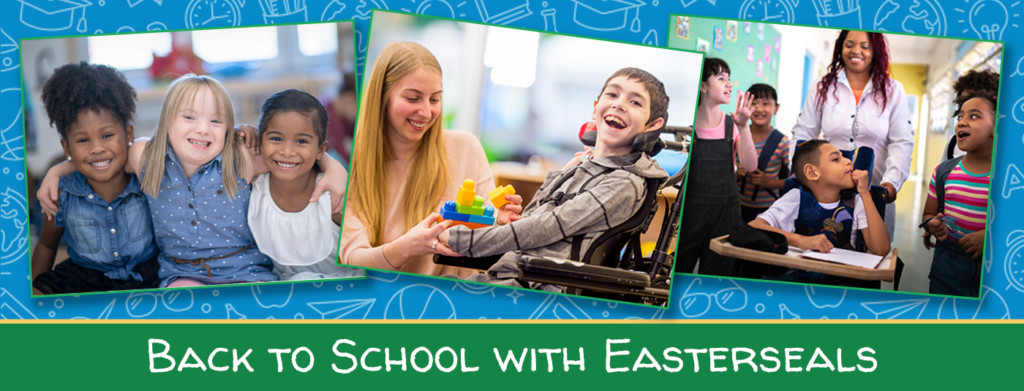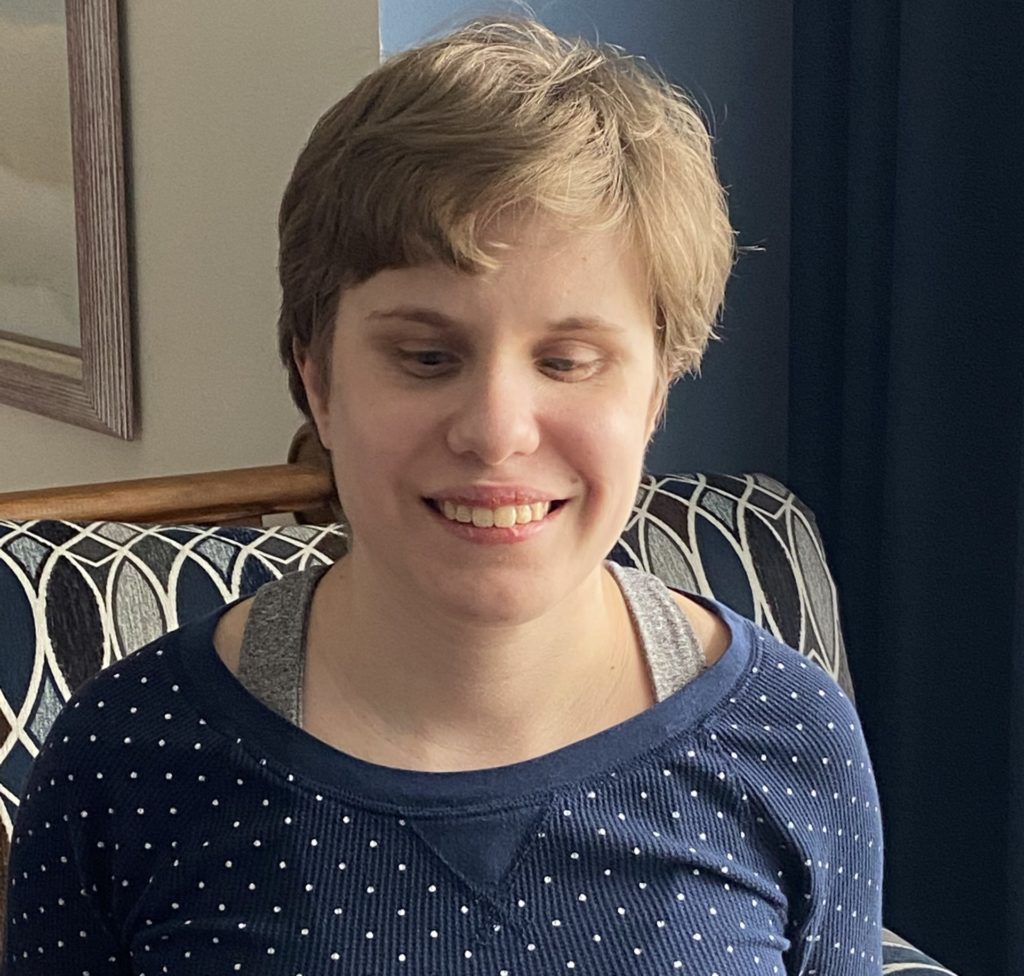Growing Up Blind: My Experience in School
by Alicia
by Alicia Krage
I reflect on my education experience a lot, especially as someone who’s been blind since birth. I think a lot about how, from a very young age, I was very fortunate to have good educational resources.
I grew up surrounded by both blind and sighted peers. It was important to my parents that I met other blind children, but that I was also around other sighted individuals as well. As I’ve gotten older, I really appreciate this. I have a nice balance now of blind and sighted friends, and I think it also helps sighted people to be exposed to people with disabilities from a young age. It enforces the concept that we’re just like everyone else. This helped me become confident in my disability. I was never sheltered or seen as less capable.
I started with a teacher named Michelle as part of Parent Infant Education as soon as I came home from the hospital. For the first year, Michelle would come to the house once a week. After that, my mom took me to the SASED office after they contacted her.
This didn’t just impact me, but it was great for my parents as well. It taught them that I may be sensitive to texture — I didn’t like touching things or putting things in my mouth, which I hear is common amongst blind children — but also taught them things about saying the same thing before picking me up, since I couldn’t see someone approach.
This program then led to preschool. I started preschool at age three. My parents were able to meet the teacher, Marta, and visit the classroom. During my preschool education, I was in a classroom full of blind and visually impaired students. This is when I began learning Braille and was also introduced to the white cane. I learned about advocacy, navigating the school, and how to interact with blind and sighted children, and my parents learned about what I would be expected to do for myself.
I began mainstream school starting in kindergarten. In every school I went to, there was the vision resource room where students who weren’t mainstreamed were taught, so sighted students grew accustomed to seeing us walk the halls every day. Often times, I was the only student in my classroom with a disability. I wasn’t often in the same class as my other blind friends. The only time I was in a classroom of blind and visually impaired students was my physical education class — they called it adaptive P.E. To this day, I still fondly reflect on my very first sighted friend I ever made. I don’t remember exactly what our class was doing — maybe drawing? — but I was just kind of sitting off by myself. I remember it was sort of a visual activity that I didn’t know how to join. I heard a little voice say, “why are you sitting here by yourself?” She took my hand and led me to her table to describe what she was doing. Even at the age of six, she was very unphased by my blindness.
As I got older and continued my education, from primary school to middle school and then on to high school, a lot of my education was like that: students were unphased by my blindness. Often times, I was the only blind student in the classroom. This wasn’t an issue by any means. Students were happy to read things on the board if the teacher was talking too fast. I even had a few offer to take notes for me. I declined, but I appreciated the gesture.
There were some moments when I had to explain a little more how being blind makes things a little different and sometimes a tad bit complicated.
One of my struggles was textbooks. Because Braille takes up much more space, textbooks came in volumes, and the page numbers didn’t often match the print page numbers. If a teacher told me to read chapter 6 starting on page 190, for example, it wasn’t always on page 190. And it wasn’t always just one book. Sometimes, multiple books had to be lugged around for reading homework.
Understandably, this was often a difficult concept for teachers to grasp — after all, people reading this post who don’t have firsthand experience with this are likely confused! This meant a lot of planning ahead. Sometimes, upon entering a classroom, teachers would have to tell me ahead of time what we’d be reading that week so I could retrieve the textbooks. Our books were kept in the vision resource room where blind students were taught and equipment was kept. To combat this page number issue I so often encountered, I’d use my book’s table of contents, but also ask sighted students to read the first few sentences of the chapter to make sure I was on the right track.
Generally, I loved how accommodating and patient my teachers were throughout my educational career. The only time I would ever say that it affected me as a student with a disability was having to get pulled out of classes for other things, like orientation and mobility training. Often times I was just pulled from something like study hall, or my adaptive physical education class, but if it was a longer trip — say, learning a bus system or taking the train into the city — I’d have to miss class. My teachers were patient and understanding about this, but I remember feeling like my classmates might feel jealous and wish that they could skip class, too. No one ever said this to me, but I never felt like I was getting special treatment. It was cool to take the day off sometimes for a mobility lesson, but explaining it sometimes felt strange.
All in all, though, my high school experience was great. I then attended the Illinois School for the Visually Impaired in Jacksonville. I hadn’t been in a classroom with just blind and visually impaired students since I was three. I was 19 now, so this felt brand new. I didn’t have any memories of my preschool days. I think this is when my confidence in my disability really flourished. Not only was I surrounded by people who had similar experiences and struggles as me, so there was that sense of camaraderie, but it helped me gain independence as I learned more about traveling and independent living. I shared an apartment, so I learned what it was like to have a roommate. My roommate was also totally blind. Teachers were accustomed to students missing classes due to orientation and mobility lessons, so that wasn’t as big of a deal. Even some of the teachers were visually impaired! It was a different environment and experience, but it was a very life-altering two years for me. It was my first time being far from home (the school was roughly 200 miles away from my hometown), and I felt very self sufficient. Since then, I feel like I’ve had a very positive outlook on my disability, carrying it and myself well as I move through the world.
I recognize that not everyone grows up with as many resources, but I am fortunate that I did. It helped me advocate for myself when I moved on to college, confidently requesting accommodations for assignments and extended time on tests. Dorm life was easier since I was used to being away from home. It helped me gain my confidence outside of school, too; I started confidently taking public transportation — cabs, buses, RideShare, and eventually taking a solo flight. My educational experience since I was born gave me the confidence to thrive and perceive my disability not a hindrance, but just a part of who I am. It has never defined me as a person, though.
As I have said to many people: It is part of my story, but it is not my whole story.
Alicia Krage is a graduate of Northern Illinois University. She relocated to Houston, Texas in early 2023 where she found a great community of people with disabilities. She has a passion for writing, centering her posts on advocacy, inclusivity, and relationships as a totally blind person.









